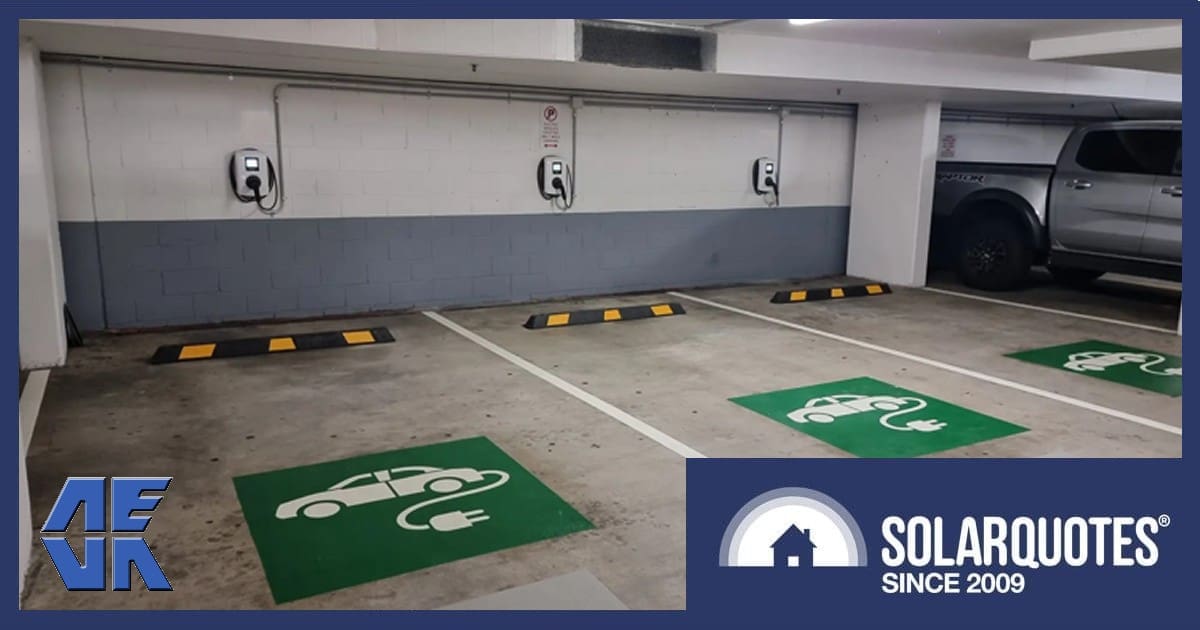
Owners corporations and bodies corporate preventing the installation and use of EV charging equipment in strata developments will hold back electric vehicle uptake in Australia says the AEVA.
Founded after the oil price shock in 1973, the Australian Electric Vehicle Association is the world’s longest continuously running EV society. Its goal is to see Australia’s transport networks switching to electric vehicles as soon as possible.
Among the barriers to this happening are owners corporations and bodies corporate that refuse allowing installation of EV chargers, often based on fire safety grounds. With at least one in six Australians living in strata-titled properties such as apartments and units, such bans have the potential to negatively impact many current and future EV owners.
But according to EV Fire Safe, a private firm supported by the Australian Department of Defence to research EV battery fires and emergency response, fire safety fears aren’t backed by data:
“Put simply, in normally operating road-registered EVs, it is electrically impossible for the battery to be overcharged so it catches fire while using an electrically compliant unit that has been installed to standard by a qualified person.”
The organisation has determined the primary causes of damage leading to an EV battery fire are:
- Collision / road debris
- (Extended) submersion
- Recall issues
- External fires
The AEVA wants to the ‘right to charge’ an EV at a person’s home – whether that’s a stand-alone dwelling, townhouse, unit or apartment – enshrined in harmonised legislation across Australia.
“There are no good reasons why this should not be permitted by default by an owners corporation,” said Dr. Chris Jones, AEVA National President. “Such rights are common throughout Europe, Scandinavia and parts of America.”
Dr Jones says the ACT leads the way in Australia, with the Territory’s Unit Titles (Management) Act forbidding any owners corporation rule that unreasonably prohibits or restricts the installation or operation of sustainability infrastructure – and this includes EV chargers.
EV Battery Fires *Very* Uncommon
EV Fire Safe’s initial research based on global EV battery fires from 2010-2020 indicates a 0.0012% chance of a passenger electric vehicle battery catching fire (all causes). While determining internal combustion engine (ICE) passenger vehicle fires globally is difficult, based on various country reports the organisation suggests there is a 0.1% chance of an ICE vehicle catching fire; so much more likely.
But while rare, EV traction battery fires can be very challenging to deal with. They burn hotter, spew toxic gases, and thousands of litres of water is required to cool the battery and suppress flame. And if it’s not possible to allow the traction battery to ‘burn out’, it can reignite hours or days later.
EV Fire Safe has published a guide to suppression methods.
Electric Bikes And Scooters Need Special Attention
It’s a different situation with e-micromobility devices, such as scooters and e-bikes. There have been a number of fires involving these personal electric vehicles, sometimes caused through using incorrect or poor quality aftermarket chargers imported into the country.
While the AEVA wants to see greater uptake of e-bikes and electric scooters as well, the organisation warns consumers need to be careful to avoid low-quality products.
“Only equipment carrying the Regulatory Compliance Mark should be used, and charging of e-bikes and e-scooters really ought to be done where the risk of fire propagation is low. Ideally, apartments should have a dedicated e-bike and e-scooter charging area,” said Dr. Jones.
The Regulatory Compliance Mark (RCM) looks like so:
There has been some progress on this front, for example in New South Wales. Since the beginning of February this year, lithium-ion based e-micromobility devices sold in the state must comply with prescribed safety standards.
For strata-living EV owners facing charging challenges such as ornery owners associations (and other hurdles), SQ has published a comprehensive guide to strata charging.


 RSS - Posts
RSS - Posts



Normally I would be right behind this, but a recent video by Finn that showed townhouses that only had a 40 amp breaker makes me start to think about the ramifications of the load on the main board into such complexes once a few charging stations are installed.
Yes smart dynamic chargers are they way to go to protect your board / supply – but I doubt very much they are smart enough to know the mains feed to that main board may be getting close to capacity?
Because I’m not sure 10 townhouses with 40 amp circuits are being fed by a 400 amp mains supply to the main board, I suspect the main feed would be much lower than what would be required if a significant amount of the units were pulling their maximum allowed amps.
I mentioned this in comments below. However, it would not be too difficult to have the body-corporate insist on management of any connected charger: easy with OCPP. They could even have a Home Assistant server set up to manage the chargers dynamically via OCPP, & insist all connected chargers are OCPP compliant & available to the Body corporate network. User-pays could also be included too, probably with an external manager.
Sounds like it is fairly easily doable then! – as long as people play ball!
Right, 400A is unlikely because the main breaker can rely on load diversity between the units. Likewise, individual units can rely on load diversity within the unit. For most people, 10A charging is good enough and can be done in low demand periods.
Hopefully this sort of pushback won’t lead to many legal challenges.
All the non informed lump all lithium batteries in the same pile, ready to explode and burn the building down at any second.
You see it all over YouTube, the MSM news article comments, and forums / other social media posts about batteries.
The cheap Chinese lithium batteries in e-bikes and scooters, cheaper drones, for cheaper rechargeable tools, etc are the issue, cheaply made, using rubbish BMS protections, or people using aftermarket chargers.
Sure, Li battery fires can be very difficult to deal with, and it doesn’t matter if they catch fires after an accident, or in a carpark where an ICE vehicle has casued a lines of cars to go up.
I’m thinking battery advancements / changes in chemistry might mitigate fire risk somewhat, eg sodium ion batteries are supposedly safer.
Are there other battery tech that is safer now ?
The BYD Blade batteries compared to regular cells ?
BYD Blade batteries advertise being “safe” with a nail being driven into them:
https://youtu.be/CSGESKhtZD0?t=7
I suspect any LiFePO4 batteries are similar:
https://youtu.be/pBDW223E3JI?t=1
Property rights are such a pain. We should just make the government own everything.
Canada’s headed that way. Not sure which country’s government it’ll be yet, though.
Isn’t the important message that low power EV charging is very safe ? When the numbers of EVs get higher, it’ll get harder to sell units without any charging, so the market will dictate.
I don’t think the government should make charging availability mandatory unless they’re going to fund it, though. And even then government often means big money, badly spent.
At the recent Energy Conference in Sydney, a company is marketing a power point that can be locked, so the user can plug in a Granny charger (ie max 10A). That circuit is linked to the consumers power board, so is installed in their parking allocation.
I am not a huge fan of Granny chargers, but if the power point is Industrial grade (which apparently has higher contact pressure) there is lower possibility of the point overheating. Personally, I think all chargers should be sold with screw ring power plugs for better retention.
I see a problem with having dedicated charging parking spots that are not linked to a particular tenant in that ICE vehicles will park restricting their use. But if a 15A industrial point is installed at every parking location, that is OCPP linked, then the points are managed by an external operator (eg ChargeFox), with power supplied by the body corporate, where the body corporate makes a small profit on the transaction I consider everyone wins.
Nearly every private, outdoor parking spot in Canada has a 15 amp, but only 120 volt, plug. To keep car engines from getting too cold to start.
The summer charging problem is basically solved, except underground lots haven’t got plugs, and in winter when 1340 watts isn’t enough to get the battery warmed to chargint temp.
But I think the long term solution is pay-to-charge points with long cables stuck between visitor and assigned parking. And then some reasonable trading between residents so the ones who need EV charging can get it.
The Company mentioned above is:
https://www.alchemycharge.com.au
Their management charge of 10c/kwh is I feel a bit high, but others will compete with similar products I feel. (There is no rocket science in their idea: just an OCPP compatible power point, with external management thrown in.)
But I do like the concept: Manage the power points, with energy management to reduce overloading of building supply dynamically. I feel this will be necessary in the future. Buildings will also be able to use body-corporate owned pv to offset the power costs too.
I understand they have a law in Oslo which gives owners in shared buildings the right to charge. It would be worthwhile looking at that legislation.
Another thought is that many cars which are not heavily used could be charged at 2 kW (or less if that is technically possible). A 2 kW charge for four hours would give over 40 km of range.
Apart from technical issues raised in other comments, the real issue is the lack of coverage of EV charging regulatory frameworks within construction codes including the National Construction Code that allow insurance companies to avoid coverage and/or exorbitant premium increases. AEVA might campaigning for codification of EV charging installations that are acceptable to insurance companies prior to the introduction of a “right to charge”.
Good quality, standards compliant gear installed by licensed electricians.
https://fleetevnews.com.au/ev-insurance-myths-busted-iag-confirms-zero-fire-risk-and-supports-fleet-transition/
Lack of knowledge is the main problem. A level 1 (Granny) charger draws less power than a hairdryer and can safely be used in a standard 10 amp GPO. There would be hardly any apartment blocks that could not cope with every existing powerpoint being used concurrently in that way without overloading the building power supply.
New powerpoints, and chargers above Level 1, require an electrician to certify compliance with all standards which takes account of all load issues as well.
There is not a single house/apartment that would be able to cope with every existing power point used at their rated capacity. Just count how many power points in your house, then add hardwired staff like AC, cooktop, water heater and so on. Then multiply the result by 10A rated power for each point and check your circuit breaker power.
There are always many times more power points than energy available. If all apartments in the building block switch on a hair drier and microwave and electric kettle at the same time – that block will die even without a single EV.
It will change once the additional rents the apartment can use are enough to cover the capital costs. The additional rents depend on demand, so therefore will actually depend on EV takeup. However renters don’t want to get EV’s if there won’t be places to charge. Chicken and egg.